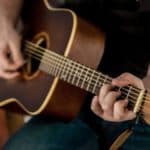Many guitarists find themselves getting stuck after learning how to play barre chords.
They are perhaps the main big hurdle we all have experienced when learning the instrument.
But when you learn how to pull off that painful F chord and incorporate new songs that use it into your repertoire, you might start wondering “What’s next?”
And learning an instrument is not a linear task, where you absolutely have to follow a certain path.
Of course, there are fundamental building blocks that you need to step on when advancing your journey, but at some points, the roads start forking, and you might get a bit lost.
In this article, I will discuss ideas on how to break these barriers and learn new tricks to expand your guitar playing exponentially.
However, if you just want a short answer about this topic, here it is:
After you get a hang of barre chords in the guitar, there are many techniques and concepts to learn in order to continue your journey, such as learning new chords, arpeggiated/broken chords, working on solos and riffs, learning scales such as the pentatonic, new rhythms and music theory in general.
Are you ready to get started?
Let’s go!
There’s not a predetermined path for learning the guitar
Although there are different methods, it all depends on the teacher and the interests of the players.
There’s nothing set in stone, and although you should try to progress incrementally, there’s no point in getting stuck with some technique or style you don’t enjoy.
Every guitar player is different and will take their own spin on learning the instrument.
And, of course, a big factor to define is what are your expectations as a guitarist.
If you just want to strum some songs and sing along, and that’s all: Congratulations, you’ve made it.
Probably your next thing to focus on would be learning new songs.
However, if you want to know everything there is to know about the guitar, you are just starting out, and here are some ideas that might motivate your interest.
Learning new chords
One area to work on is chord extensions and new types of chords, which is an endless funnel of new information to learn.
Some ideas would be learning your major and dominant 7 chords in both root positions or inversions!
Once you have a good grip on these types of chords you can begin adding in simple extensions like 6, 9, 11, and 13 which will help add some new flair to your playing.
And when you are done with this, you are not really done.
That is because there are many ways to play each and every chord along the fretboard of the guitar.
These are called different voicings for the same chords.
The rabbit hole is endless, and you can go as deep as you want to.
Work on playing broken/arpeggiated chords
Breaking down chords will add versatility to your playing and provide you with an alternative to strumming when accompanying someone.
For example take a barre chord on the fifth fret, strum one note at a time from low string to high then back again.
This style of playing can be heard in many styles of music ranging from folk and classical to rock and jazz!
It will work as a great exercise for your rhythm, and also will help your chords to sound cleaner.
There are also many different picking patterns that you can try, or even mix to spice up your playing.
Learn some simple solos or melodies
An important part of guitar playing is working on form and new techniques.
One way to do this is by playing a solo you really like or trying to pick up common melodies and play them back on the guitar.
Working on this is a good way to expand your knowledge of bends, pull-offs, hammer-ons, slides, etc… Start with simple exercises and work your way up!
Soloing is a completely different world from playing rhythm and it may take you some time to find your own voice.
Learn riffs from songs you like
A great way to feel inspired is by playing music you really enjoy.
Pick a song or two by your favorite artist, search up the tabs or sheet music (depending on your preference) and try learning the song.
Not only will you learn something great and add to your playing, you will more likely than not also be able to play songs you know quicker, because you are familiar with it already.
Focusing on riffs exclusively will help you improve your sense of rhythm apart from strumming.
Learn the pentatonic scale
The pentatonic scale is the cornerstone of many genres and a must-know for all players.
Using the pentatonic scale is the absolute base of soloing in most genres of music and is a great kick-off point for learning how to improvise.
Take it slowly, learn the different shapes and practice them as much as possible!
Learn other scales
Broaden your vocabulary with other scales and modes to better understand what you are playing, and even start crafting your own tunes.
Some ideas for scales to learn outside of the pentatonic scale would be the major scale, the modes (Mixolydian, Phrygian, Lydian, etc..), the minor scales, or diminished scales.
There are unless scales and to learn and more than enough options to keep musicians of any level entertained.
Learn how to improvise
Improvising is one of the best things about playing guitar, and you should learn how to do it as soon as you start getting used to the instrument.
Start gradually, something like the pentatonic is a great tool, to begin with, but, you will quickly find yourself hitting a wall with what you can do.
Try pulling up backing tracks, working through licks, and finding new ideas on the neck.
Learn new rhythms and styles
A very large distinction between pro/advanced guitar players and intermediate guitar players is their ability to play vastly different styles of guitar.
If you’ve started with folk or country, try learning rock or metal, push the limits of your playing and make a point of leaving the comfort zone, you will never regret it.
This is integral to learning more and maturing as a player, play as much as you can, whenever you can, with the largest variety possible.
Learn some music theory
Though it may be boring at first, learning music theory is a great way to grow not only as a guitar player but as a musician.
All throughout the app store on android and apple, you can find daily ear training and music theory lesson apps.
Take advantage of these tools and learn more about the science side of music, because it will guarantee you results in your understanding of music.

Hello there, my name is Ramiro and I’ve been playing guitar for almost 20 years. I’m obsessed with everything gear-related and I thought it might be worth sharing it. From guitars, pedals, amps, and synths to studio gear and production tips, I hope you find what I post here useful, and I’ll try my best to keep it entertaining also.





